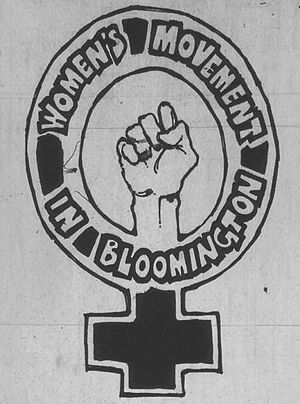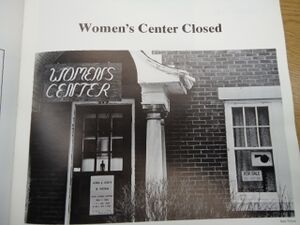Women's Spaces and Lesbians in Feminism
Separate women’s spaces have historically played a significant role in lesbian communities, especially for lesbian feminists. Prior to the 1970s,
lesbian house parties and the meetings of membership-based organizations like the Daughters of Bilitis served as sometimes safer alternatives to frequently-raided bars. But even as bar raids diminished in frequency in the ‘70s and ‘80s, women-only and women-centered spaces continued to play important roles in the life of Bloomington’s lesbian, women’s, and feminist communities.
Radical Feminists Organized in Bloomington Before Gay Men
According to Suzanne Staggenborg, a professor of sociology at McGill University from whose research on women’s movements much of this article is drawn, Radical feminists organized in Bloomington before gay men did. Bloomington Women’s Liberation held its first meeting in 1969, prior to the organization of Bloomington GLF. The group drew hundreds of participants to its monthly business meetings and consciousness-raising groups, where Hoosier women tackled issues ranging from sex education and abortion to day care and job discrimination. The group survived until 1974.
Lesbians in Bloomington GLF
Some lesbians initially participated in Bloomington GLF when it formed in 1970, but lesbians formed a separate Gay Women Liberation Front (GWLF) as a lesbian alternative to the mostly gay male GLF after several women complained of sexism in the group. GWLF operated in tandem with the GLF as a partner organization, which allowed lesbian women to engage with one another in a woman-centered space, and to distribute their own information and organize their events while still maintaining contact with the predominantly male group. Another group called “Lesbian Liberation” was also active in Bloomington in the mid-1970s.
The Park Street Women's Center and Alternative Feminist Institutions
A Women’s Center operated out of a rented house at 414 North Park Avenue in Bloomington starting in 1970, and published a feminist newsletter called The Front Door. The Park Street Women’s Center served as a staging ground for many feminist actions, as well as a social gathering spot for lesbian meet-and-greets and support groups. It was part of a broader effort to establish alternative institutions, such as the cooperative day care center organized by women’s liberationists at the Unitarian Church in 1970, and the Bloomington Women’s Health Collective organized at the Park Street House in 1972, which put into practice many of the ideals espoused by the
path-breaking new book from the Boston Women’s Health Collective, Our Bodies, Our Selves. Women Against Rape formed at Park Street House, and operated the Women’s Crisis Center rape help line. The Park Street Women’s Center closed abruptly in 1975 when the house was sold.
A Room of One's Own
A women’s bookstore called A Room of One’s Own opened about the time the Women’s center closed, and, besides selling books, took over some of the defunct center’s functions as a meeting place, staging ground, and venue for consciousness-raising sessions. The shop ran into financial difficulties late in 1976 and closed for several months, until a group of women calling themselves the Xanthippe Collective formed to rescue the failed business. They ran the bookstore as a cooperative that relied on a volunteer labor pool of straight feminists, lesbians, and women grad students from the university, and managed to keep the doors open until 1982.
Some Bloomington lesbians shared space with gay men as well as heterosexual feminist women. The New Horizons Center, which opened in 1975 at 809 South Rogers Street, tried to serve the entire gay and lesbian community. Tuesdays were “Womyn’s Night,” where, according to New Horizons board member Donna Reeves, writing in the “Womyn’s Column” in New Horizons Newsletter, “anything can happen,” from live entertainment or recorded music, to just sitting around talking, to playing games, dancing or even having a giant slumber party!” The Center also offered a “Womyn’s Herb Class,” and Womyn-on-Womyn massage instruction (Newsletter, 4). Bloomington lesbians also participated in the gay coffeehouse that took place Friday nights at the University Lutheran Church at 7th and Fess, starting in 1975, where the all-womyn band Ruby frequently held court.
Sources:
Berry, Jae. June 24th, 1974: Women’s center mural reflects liberated mood. Indiana Daily Student, 1st page.
Hinchion, Gail and Jae Berry. March 25th, 1974: Women’s week: Workshops draw varied response. Indiana Daily Student.
Marilyn , Moores. "Lesbians Seek Solidarity." Indiana Daily Student, 11 February 1976, sec. c, p. 1.
Simon, Cheryl. September 2nd, 1974: Women’s center hosts lesbian dinner. Indiana Daily Student, 11th page.
Staggenborg, Suzanne. “The Survival of the Women’s Movement: Turnover and Continuity in Bloomington, Indiana,” http://mobilization.metapress.com/media/80ppqgqhumh31y32wmf0/contributions/j/1/5/6/j156r9529q553166.pdf.
Staggenborg, Suzanne. “Beyond Culture versus Politics: A Case Study of a Local Women's Movement” Gender and Society, Vol. 15, No. 4 (Aug., 2001), pp. 507-530.
Toby Strout, e-mail message to Evelyn Smith, December 4, 2009.
New Horizons Newsletter 1:1, 1975.
Navigation | Home | Before Stonewall | Stonewall to AIDS: the 70s |
AIDS and Community Life: the 80s | The Queer Decade: the 90s | Queer Here and Now: 2001-Present
<comments />

